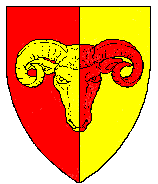War-o-t-Roses-art - 9/4/00
“The War of the Roses” by Jan van Seist.
NOTE: See also the files: Isabella-art, Joan-of-Arc-art, Lamoral-art,
Margaret-art, Otto-T-Great-art.
************************************************************************
NOTICE -
This article was submitted to me by the author for inclusion in this set
of files, called Stefan’s Florilegium.
These files are available on the Internet at:
http://www.florilegium.org
Copyright to the contents of this file remains with the author.
While the author will likely give permission for this work to be
reprinted in SCA type publications, please check with the author first
or check for any permissions granted at the end of this file.
Thank you,
Mark S. Harris
AKA: Stefan li Rous
stefan@florilegium.org
************************************************************************
[NOTE - originally written for Storm Tidings, the newsletter of the
Shire of Adamastor (Cape Town) in the Kingdom of Drakenwald]
The War of the Roses
by Jan van Seist
As the mundane history lessons that many of us recieved in our youth
concentrated excessively on the mundane, many of the nobles of our fair shire
(HUZZAH!), have been left with a confused picture of mediaeval history. In
order to add to the confusion, I have provided for your pleasure a brief
synopsis of one of the less rational events in mediaeval history: the War of
the Roses.
In the mid 15th century, the English regent, John, duke of Bedford,
brought the hundred years war to a successful conclusion by allowing the French
to take France (thus introducing some badly needed common sense into 15th
century political geography). This freed the English to fight the only foe
truly worthy of their steel - the English. This in turn left the rest of Europe
free to renaisse to their hearts content.
Following John’s regency a new king, Henry VI, was crowned (HUZZAH!). A
thoroughly nice, peace loving and honourable man, Henry VI was obviously unfit
to rule. Moreover, as his opponents pointed out, any member of the Plantagenet
family who wasn’t a bastard was undoubtably illegitimate. Therefore, on the
advice of Neville, earl of Warwick, Henry’s cousin, Richard, duke of York,
declared himself king (HUZZAH!) on the grounds that either his grandfather or
his great grandfather was the third son of Edward III. King Henry VI disagreed
on the grounds that he was King Henry VI. War seemed inevitable.
The nobility were delighted at the prospect of the first decent war for
months. They promptly picked sides and proceeded to rape, pillage and plunder
in all directions. Those that supported Richard took the white rose as their
badge and those that supported Henry took the red rose. Most of them forgot to
consult either Richard or Henry.
Why were roses chosen as the symbols of the two factions? Consider the
rose: pricks for the most part but dressed in beautiful clothes and adorned
with exotic scents. Consider the English nobility ...
The situation deteriorated rapidly. Henry abdicated in favour of Richard
to avert war. Henry’s wife, Margaret of Anjou, declared war to avert Richard.
Henry de-abdicated and re-armed to avert both of them. Various battles were
fought in various places. Henry & Margaret generally lost but Richard was the
first to die. Therefore, Richard’s supporters crowned his son, Edward, King
Edward IV (HUZZAH!).
Then on the advice of Neville, earl of Warwick, Henry had another go. His
fortunes improved and he was recrowned Henry VI (HUZZAH!). Neville then
rejoined Edward’s side. Edward overthrew Henry and was, yet again, Edward IV
(HUZZAH!). The two kings and various lesser royals chased each other around the
countryside for a bit and some of the nobility got into the act. The duke of
Beaufort volunteered to be king if anyone wanted him and Thomas Mowbray, duke of
Norfolk, toured the country looking smug and pointing out that HIS grandfather
had warned King Richard II YEARS AGO that this would happen but NO ONE had
listened ...
Eventually, even Neville grew tired of the chaos and Edward IV was
confirmed as king (HUZZAH or else!) as he had killed or imprisoned all his
rivals, heirs and successors, except for his two young sons and his brothers
Clarence, duke of George and Richard, duke of Gloucester. After Edward IV was
crowned for the last time, he executed Clarence and then promptly died, rapidly
followed by the two young princes, one of whom survived just long enough to be
King Edward V (HUZZAH! *oops*). Richard, the only surviving Plantagenet, was
crowned King Richard III by default (HUZZAH?).
This brought the war of the roses to an end and everyone lived happily
ever after. Well, for a few years at any rate until, on the advice of Neville,
earl of Warwick, Henry Tudor ...
------
Copyright 1997 by Dr. I.G. van Tets. <ivantets@bgumail.bgu.ac.il>
Mitrani Dept. of Desert Ecology
Blaustein Institute for Desert Research
Midreshet Ben-Gurion
84990 Israel
Permission is granted for republication in SCA-related publications,
provided the author is credited and receives a copy.
If this article is reprinted in a publication, I would appreciate a notice in
the publication that you found this article in the Florilegium. I would also
appreciate an email to myself, so that I can track which articles are being
reprinted. Thanks. -Stefan.
<the end>

Copyright © Mark S. Harris (Lord Stefan li Rous)
All Rights Reserved
Comments to author: stefan@florilegium.org
Generated: Sat Nov 25 2000